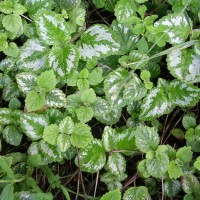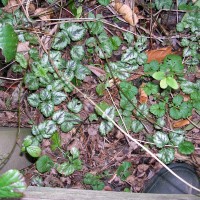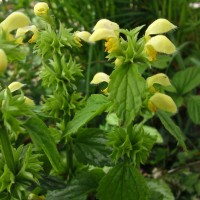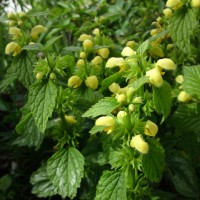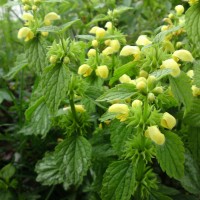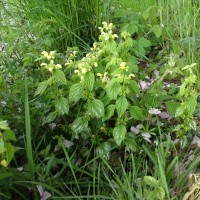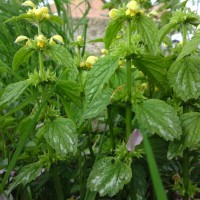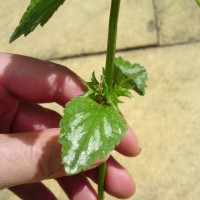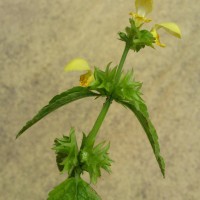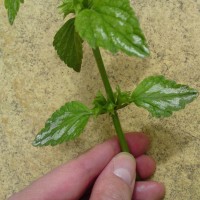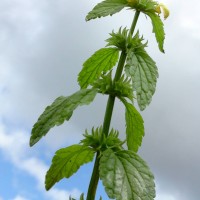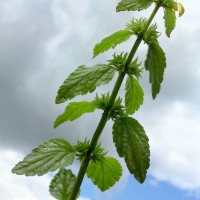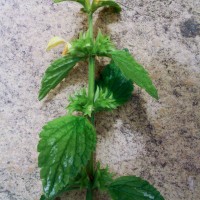
- Lamiastrum galeobdolon subsp. argentatum
Expand and collapse the sections below by clicking on the title or + / - icons.
Short description of Lamiastrum galeobdolon subsp. argentatum,
Garden yellow archangel is a low-growing "dead-nettle" with leafy runners, leaves boldly variegated in all seasons (unlike the native woodland yellow archangel), whorls of yellow two-lipped flowers streaked with brown, and four (probably sterile) fruits borne in a bell-shaped 5-lobed calyx.
Impact summary: Lamiastrum galeobdolon subsp. argentatum,
Once introduced it can form rapidly spreading dominant patches vegetatively. However its impact on conservation-worthy woodland habitat is probably less than sometimes claimed, and there is no evidence of spread by seed to new sites.
Habitat summary: Lamiastrum galeobdolon subsp. argentatum,
Woodland (usually on margins), scrub, hedgerows, verges, stream sides and waste ground in the lowlands, mostly with a degree of shade.
Overview table
| Environment | Terrestrial |
|---|---|
| Species status | Non-Native |
| Native range | Middle Europe, Southwestern Europe, Southeastern Europe, Eastern Europe, Iran |
| Functional type | Land plant |
| Status in England | Non-Native |
| Status in Scotland | Non-Native |
| Status in Wales | Non-Native |
| Location of first record | v.c.23 |
| Date of first record | 1974 |
Origin
Said to have arisen as a sport of wild Yellow Archangel in central Europe in the 1900s, then brought into cultivation. Other sources say that it was in Victorian gardens earlier than this (by 1885), but this may refer to a lightly variegated form of the native subspecies. It was not described as a separate taxon until 1975.
First Record
Advertised in GB as a prized garden plant by the 1940s, although some sources say it was not here until the 1960s. It was first recorded in the wild in Oxfordshire in 1974.
Pathway and Method
It is widely cultivated as an attractive ground-cover plant, and from plantings it becomes established in the wild by escape through the garden hedge, by dumping of garden waste or, as increasing evidence for many species suggests, as a continual deliberate introduction to beautify the countryside.
Species Status
Because of its aggressive rate of vegetative spread and the speed with which it has appeared across lowland Britain, it is often considered a high-risk invasive weed. However its ability to colonise and dominate the ground-layer in the more ancient woodlands is not well evidenced. Few sources elsewhere in Europe consider it actually invasive. North America does provide cases of its invasion of natural woodland.
Dispersal Mechanisms
Garden Yellow Archangel is spread by natural diffusion from gardens and parks; and through human agency from garden outcasts, from transport and redisposal of topsoil or from deliberate introductions into the wild (all of which are now potentially or certainly illegal if they result in infestation).
Reproduction
Establishment from seed of this subspecies is unknown and spread is by rooting from nodes of stolons. Small fragments of stolon suffice as long as they include a node. Subsequent spread at a site is by outgrowth of stolons. Quantitative estimates of rate of linear spread are of the order of 1-2 metres a year.
Known Predators/Herbivores
Eaten by slugs and by some rodents. Aphids, pyralid moths, sawfiles and leaf-mining midges are among the insect predators recorded for the species.
Resistant Stages
The more deeply rooted nodes can perpetuate the plant at a site when removal is attempted.
Habitat Occupied in GB
Lowland verges, hedge banks, wood margins, scrub and waste ground, mostly in shade particularly in the eastern half of its Great British range.
Widely distributed throughout lowland GB; in some areas rather frequent (especially in the south and south-west), in others relatively sparse (or perhaps still under-recorded). Rare north of the Central Lowlands of Scotland.
Environmental Impact
Garden Yellow Archangel forms large patches to the exclusion of other ground vegetation, especially in shady and rather humid situations. Along hedgerows this can be to the detriment of established vegetation, but its penetration into natural and semi-natural woodland appears slight from the testimony of most recent regional Floras.
The species in general is a pollen and nectar source for Bumblebees.
Health and Social Impact
None known.
Economic Impact
Eradication projects are usually local, small-scale and informal, and costings here are hard to come by. US eradication costs have been estimated (2007) between $11 and $21 per square metre if undertaken professionally.
Identification
Stace, C.A. (2010) New flora of the British Isles, Third Edition, Cambridge University Press, Cambridge.
Smejkal, M. (1975) Galeobdolon argentatum sp. nov. ein neuer Vertreter der Kollektivart Galeobdolon lutem (Lamiaceae), Preslia, 47, 241-248.
Rutherford, A. & Stirling, A.McG. (1987) Variegated Archangels, BSBI News, 46, 9-11.
Biology, ecology, spread, vectors
Packham, J.R. (1978) Biological Flora of the British Isles, No. 155. Lamiastrum galeobdolon (L.) Ehrend. & Polatschek. Journal of Ecology, 71, 975-997. (For the species as a whole.)
Preston, C.D., Pearman, D.A. & Dines, T.D. (2002) New Atlas of the British and Irish Flora, Oxford University Press, Oxford.
Chater, A.O. (2010) Flora of Cardiganshire, privately published, Abersystwyth.
Management and impact
Rotherham, I.D. (2005) Alien Plants and the Human Touch.; Journal of Practical Ecology and Conservation, Special Series, No. 4, 63-76.
General
Rotherham, I.D. (2005) Alien Plants and the Human Touch. Journal of Practical Ecology and Conservation, Special Series, No. 4, 63-76.
Spotted this species?
Distribution map
View the Distribution map for , Lamiastrum galeobdolon subsp. argentatum from BSBI
Legislation
This species is listed under Schedule 9 of the Wildlife and Countryside Act 1981. Read more about Non-native species legislation.

